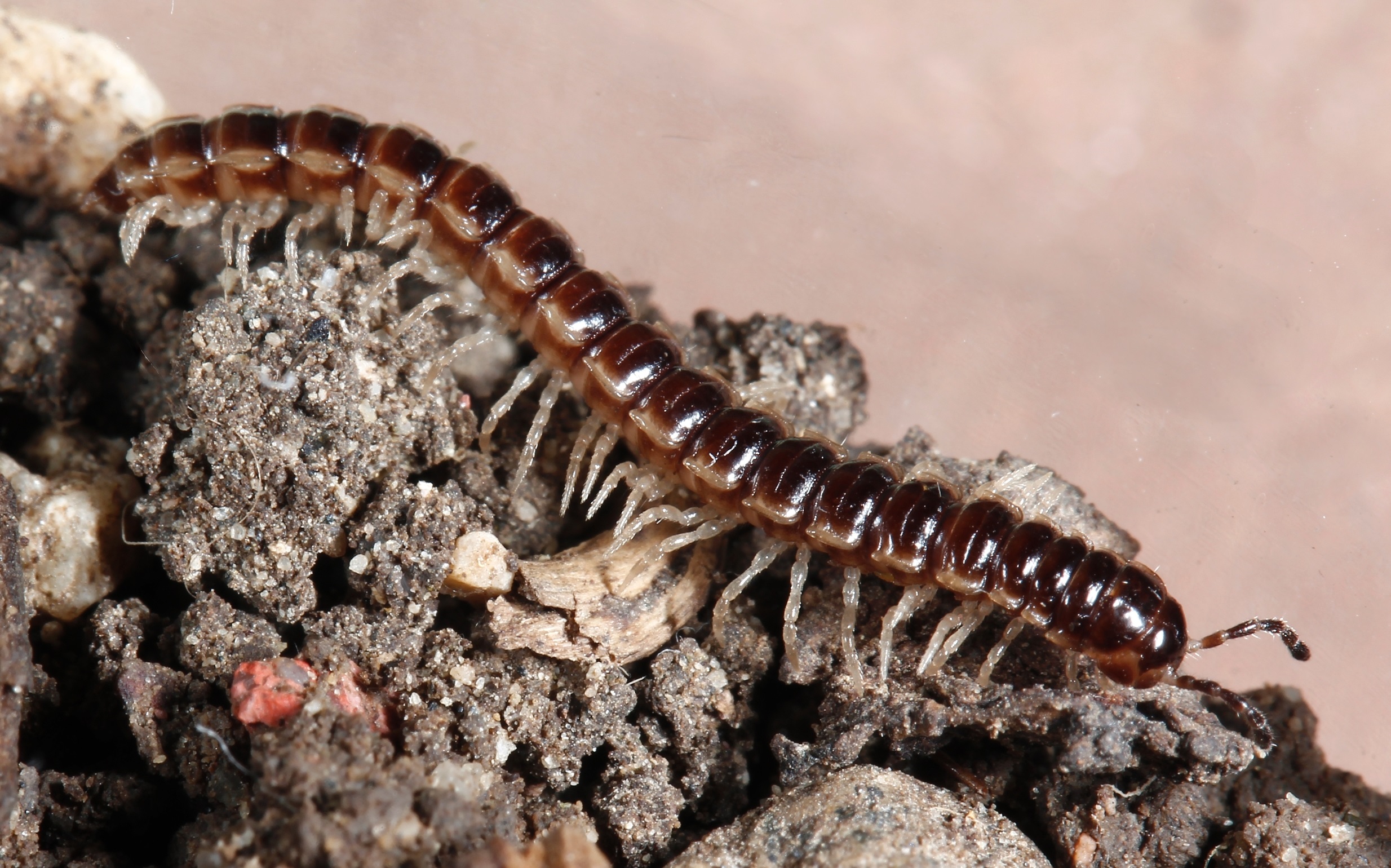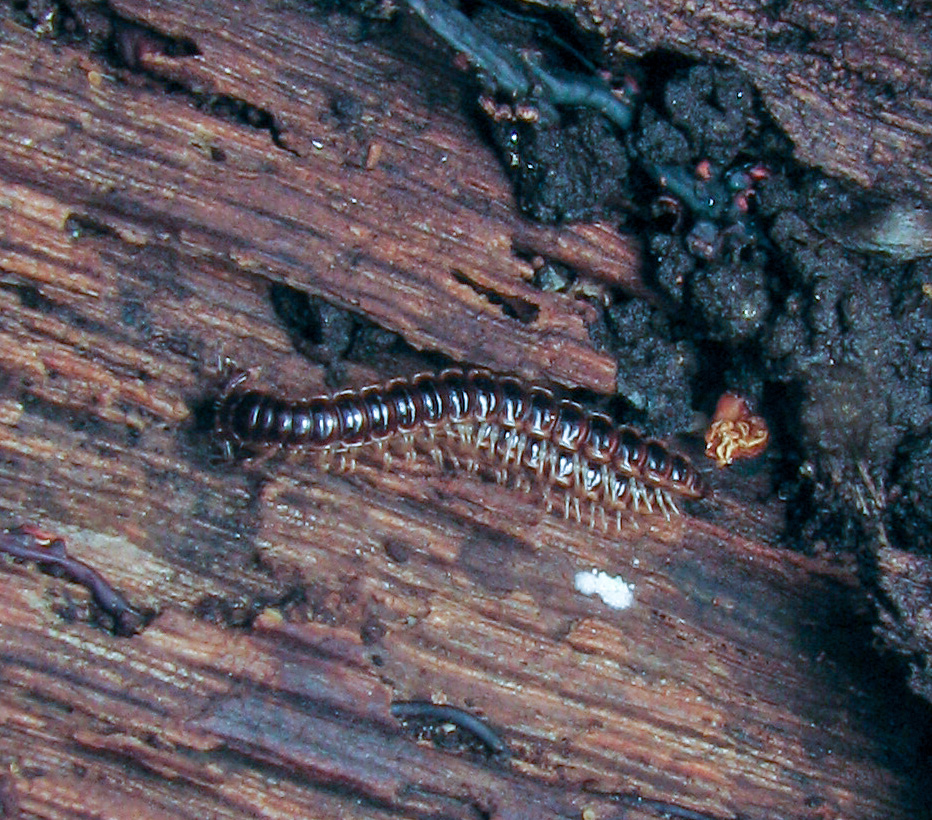|
Paradoxosomatidae
Paradoxosomatidae, the only family in the suborder Paradoxosomatidea (also known as Strongylosomatidea), is a family of flat-backed millipedes in the order Polydesmida. Containing nearly 200 genera and 975 species , it is one of the largest families of millipedes. Paradoxosomatids occur on all continents except Antarctica, and can generally be distinguished by dorsal grooves on most body segments and a dumb-bell shaped gonopod aperture. Notable groups within the Paradoxosomatidae include the dragon millipedes of Southeast Asia, and the widely introduced greenhouse millipede '' Oxidus gracilis''. Description The family is characterised by several traits. Most species possess a groove or furrow ("sulcus") on the dorsal surface between the keels ( paranota) on each segment, and the keels of the second body segment are situated lower on the body than those of the first segment ( collum) and third segment. In males, the opening on the underside of the body where the gonopods (male ... [...More Info...] [...Related Items...] OR: [Wikipedia] [Google] [Baidu] |
Polydesmida
Polydesmida (from the Greek ''poly'' "many" and ''desmos'' "bond") is the largest order of millipedes, containing approximately 3,500 species, including all the millipedes reported to produce hydrogen cyanide (HCN). Description Members of the order Polydesmida are also known as "flat-backed millipedes", because on most species, each body segment has wide lateral keels known as paranota. These keels are produced by the posterior half (metazonite) of each body ring behind the collum. Polydesmids have no eyes, and vary in length from . Many of the larger species show bright coloration patterns which warn predators of their toxic secretions. Adults usually have 20 segments, counting the collum as the first ring and the telson as the last ring. Juveniles have from 7 to 19 rings. In species with the usual 20 segments, adult females have 31 pairs of legs, but in adult males, the eighth leg pair (the first leg pair of the 7th ring) is modified into a single pair of gonopods, leaving o ... [...More Info...] [...Related Items...] OR: [Wikipedia] [Google] [Baidu] |
Desmoxytes
''Desmoxytes'', whose species are commonly known as the dragon millipedes, is a genus of millipedes of the family Paradoxosomatidae found in Southeast Asia. The genus was described by Ralph Vary Chamberlin in 1923, and reviewed by Sergei Golovatch and Henrik Enghoff in 1994. At least 18 species are known from to Malaysia, Myanmar, and Thailand. One species, ''D. planata'', has also been observed in Sri Lanka, the Andaman Islands, Seychelles, Java, Great Coco Island, and Fiji; however, this species has expanded its range by being transported through human activity. Several species have only recently been discovered, and some have yet to be officially described. Generally, species in this genus are striking in coloration and spiny, although several species are cave-dwelling, and show troglomorphic Troglomorphism is the morphological adaptation of an animal to living in the constant darkness of caves, characterised by features such as loss of pigment, reduced eyesight or blindn ... [...More Info...] [...Related Items...] OR: [Wikipedia] [Google] [Baidu] |
Orthomorpha
''Orthomorpha'' is a genus of millipedes in the family Paradoxosomatidae containing approximately 50 species distributed in Southeast Asia. Description Species of ''Orthomorpha'' possess 20 body segments and range from 15–50 mm long as adults. They range from 1.1–3.1 mm in body width, with prominent paranota (lateral keels) extending the width to 1.5–6.7 mm. Base coloration varies from brown to black, with brightly colored paranota and markings in various shades of yellow, orange, and brown, which becomes fainter in alcohol-preserved specimens. Some species have prominent bumps or "tubercles" on their dorsal metatergal segments. Distribution ''Orthomorpha'' species range from Myanmar in the west, through the entire Indochinese Peninsula, to Lombok, Indonesia Indonesia, officially the Republic of Indonesia, is a country in Southeast Asia and Oceania between the Indian and Pacific oceans. It consists of over 17,000 islands, including Sumatra, Java ... [...More Info...] [...Related Items...] OR: [Wikipedia] [Google] [Baidu] |
Chamberlinius
''Chamberlinius'' is a genus of flat-backed millipedes in the family Paradoxosomatidae. There are five species; 3 of which occur only Taiwan, one only in the Ryukyu Islands The , also known as the or the , are a chain of Japanese islands that stretch southwest from Kyushu to Taiwan: the Ōsumi, Tokara, Amami, Okinawa, and Sakishima Islands (further divided into the Miyako and Yaeyama Islands), with Yona ... of southeast Japan, and one occurring in both areas. Individuals are long and up to 5.5 mm wide, colored in pale yellow to brown, sometimes with dark brown markings on the anterior portion of body segments. Species References Polydesmida Millipedes of Asia {{Myriapoda-stub ... [...More Info...] [...Related Items...] OR: [Wikipedia] [Google] [Baidu] |
Antichiropus
''Antichiropus'' is a genus of millipede in the family Paradoxosomatidae. The genus is very distinctive in the form of the gonopod, which is typically coiled through at least a full circle. It is probably endemic to Australia. Some species have small ranges of less than 10000 km2, classifying them as short-range endemic invertebrates. See also *'' Antichiropus fossulifrons'' (Attems, 1911) – Western Australia *'' Antichiropus humphreysi'' (Shear, 1992) – Western Australia *'' Antichiropus mammilifer'' (Jeekel, 1982) – South Australia South Australia (commonly abbreviated as SA) is a state in the southern central part of Australia. It covers some of the most arid parts of the country. With a total land area of , it is the fourth-largest of Australia's states and territories ... *'' Antichiropus minimus'' (Attems, 1911) – Western Australia *'' Antichiropus monacanthus'' (Attems, 1911) – Western Australia *'' Antichiropus nanus'' (Attems, 1911) – Western Aus ... [...More Info...] [...Related Items...] OR: [Wikipedia] [Google] [Baidu] |
Asiomorpha Coarctata
''Orthomorpha coarctata'', the long-flange millipede, is a widely introduced species of Polydesmidan millipede of the family Paradoxosomatidae. It is presumed native to Southeast Asia but due to transport by humans occurs in tropical and sub-tropical areas throughout the world, including the Hawaiian Islands, the West Indies, Gulf Coast of North America, and the Galápagos Islands. Description Males range from 14.5–20.5 mm in length and 1.5 to 2.7 mm wide while females are somewhat larger ranging from 16.5–27.5 mm long, and 1.6–3.2 mm wide. ''O. coarctata'' can be distinguished from '' Oxidus gracilis'', another widely introduced Asian millipede, by having proportionally longer and pointier paranota (lateral keels) on mid-body segments and longer gonopods (male reproductive appendages). ''O. coarctata'' is unique within the genus ''Orthomorpha'' in that the gonopods have a single, simple tip, while other species have two or three lobes. This distinctio ... [...More Info...] [...Related Items...] OR: [Wikipedia] [Google] [Baidu] |
Chondromorpha Xanthotricha
''Chondromorpha xanthotricha'', is a species of millipedes in the family Paradoxosomatidae. It is native to South India and Sri Lanka. Two subspecies recognized. Distribution Although native to India and Sri Lanka, with shipping transportation, they have been introduced to many countries such as Taiwan, Philippines, Bali, New Caledonia, Samoa, Fiji, Mauritius, Guadeloupe, Jamaica, Suriname, and Puerto Rico. The species was recorded for the first time from Singapore Singapore (), officially the Republic of Singapore, is a sovereign island country and city-state in maritime Southeast Asia. It lies about one degree of latitude () north of the equator, off the southern tip of the Malay Peninsula, bor ... in 2012. Description It is about 20–26 mm in length. Adults are chestnut brown to dark grey in color. They can move very fast. Subspecies * ''Chondromorpha xanthotricha hamuligerus'' Verhoeff, 1936 * ''Chondromorpha xanthotricha hirsutus'' Verhoeff, 1936 ... [...More Info...] [...Related Items...] OR: [Wikipedia] [Google] [Baidu] |
Desmoxytoides
''Desmoxytoides hasenpuschorum'' is a species of millipede and the only species in the monotypic genus Genus ( plural genera ) is a taxonomic rank used in the biological classification of living and fossil organisms as well as viruses. In the hierarchy of biological classification, genus comes above species and below family. In binomial nom ... ''Desmoxytoides''. It lives in Australia. This species is closely related to the dragon millipedes of the genus ''Desmoxytes'', and there is some speculation, even by Robert Mesibov, the genus authority, that the split may not be necessary. While ''Desmoxytoides hasenpuschorum'' is similar to the millipedes of ''Desmoxytes'' in paranotal form and metatergite sculpture, it has a simpler gonopod telopodite with an unprotected solenomere which gives it its own monotypic genus. This species has the ability to produce hydrogen cyanide to ward off predators. References Polydesmida Millipedes of Oceania Arthropods of Australia ... [...More Info...] [...Related Items...] OR: [Wikipedia] [Google] [Baidu] |
Oxidus Gracilis 5515555-LGPT
''Oxidus'' is a genus of flat-backed millipedes in the family Paradoxosomatidae Paradoxosomatidae, the only family in the suborder Paradoxosomatidea (also known as Strongylosomatidea), is a family of flat-backed millipedes in the order Polydesmida. Containing nearly 200 genera and 975 species , it is one of the largest fami .... There are about nine described species in ''Oxidus''. Species These nine species belong to the genus ''Oxidus'': * '' Oxidus avia'' (Verhoeff, 1937) * '' Oxidus circofera'' Verhoeff, 1931 * '' Oxidus filarius'' Attems, 1932 * '' Oxidus gigas'' (Attems, 1953) * '' Oxidus gracilis'' (Koch, 1847) (greenhouse millipede) * '' Oxidus kosingai'' Wang, 1958 * '' Oxidus obtusus'' (Takakuwa, 1942) * '' Oxidus riukiaria'' (Verhoeff, 1940) * '' Oxidus sontus'' (Chamberlin, 1910) References Further reading * * External links * Polydesmida Millipedes of North America {{myriapoda-stub ... [...More Info...] [...Related Items...] OR: [Wikipedia] [Google] [Baidu] |
Greenhouse Millipede
The greenhouse millipede (''Oxidus gracilis''), also known as the hothouse millipede, short-flange millipede, or garden millipede, is a species of millipede in the family Paradoxosomatidae Paradoxosomatidae, the only family in the suborder Paradoxosomatidea (also known as Strongylosomatidea), is a family of flat-backed millipedes in the order Polydesmida. Containing nearly 200 genera and 975 species , it is one of the largest fami ... that has been widely introduced around the world, and is sometimes a pest in greenhouses. Description Greenhouse millipedes achieve lengths of as adults, and widths from . The dorsal section of each segment has a transverse groove, a trait found in most paradoxosomatids. They are brown in color with pale cream-colored legs and paranota (lateral "keels" extending from each segment). Distribution Greenhouse millipedes are thought to be native to Japan, but have been introduced globally. They are found in the tropics as well as temperate Nort ... [...More Info...] [...Related Items...] OR: [Wikipedia] [Google] [Baidu] |
Millipede Families
Millipedes, myriapods of the class Diplopoda, contain approximately 12,000 described species organized into 16 extant orders and approximately 140 families. This list is based on Shear, 2011, sorted alphabetically by order and taxonomically within order. Note: The names of millipede orders end in "-ida"; suborders end in "-idea". Superfamilies end in "-oidea", while families end in "-idae". Callipodida Suborder Callipodidea * Callipodidae Suborder Schizopetalidea * Abacionidae * Caspiopetalidae * Dorypetalidae * Paracortinidae * Schizopetalidae Suborder Sinocallipodidea * Sinocallipodidae Chordeumatida Suborder Chordeumatidea Superfamily Chordeumatoidea * Chordeumatidae * Speophilosomatidae Suborder Craspedosomatidea Superfamily Anthroleucosomatoidea * Anthroleucosomatidae * Haasiidae * Origmatogonidae * Vandeleumatidae Superfamily Brannerioidea * Brachychaeteumatidae * Branneriidae * Chamaesomatidae * Golovatchiidae * Heterolatzeliidae * Kashmireumatid ... [...More Info...] [...Related Items...] OR: [Wikipedia] [Google] [Baidu] |
Gonopod
Gonopods are specialized appendages of various arthropods used in reproduction or egg-laying. In males, they facilitate the transfer of sperm from male to female during mating, and thus are a type of intromittent organ. In crustaceans and millipedes, gonopods are modified walking or swimming legs. Gonopods may be highly decorated with elaborate structures which may play roles in sperm competition, and can be used to differentiate and identify closely related species. Gonopods generally occur in one or more pairs, as opposed to the single (un-paired) reproductive organs such as the aedeagus of insects or the penis of harvestmen. Insects In insects, gonopods are appendages of the genital segment that may be used in insemination, or that comprise the egg-laying apparatus. Crustaceans In male decapod crustaceans, gonopods are modified swimming appendages (pleopods). The anterior two pair of pleopods in males are modified for sperm transferring, with differing degree of morpholo ... [...More Info...] [...Related Items...] OR: [Wikipedia] [Google] [Baidu] |

.jpg)



